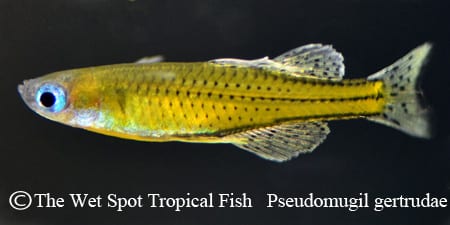Double Rainbow
Double Rainbow
If last week’s ‘Rainbow Connection’ wasn’t majestic enough, how about a double rainbow across the sky? With dozens of rainbowfish species swimming in our midsts, we felt our other shining Pseudomugils deserved to ‘ride the wave’ into this week’s spotlight. Endemic to Australia and New Guinea, species in this genus range across many habitats, just as their namesake arc wide spans. This particular trio show a proclivity for settings with plentiful vegetation, and are perfect for brightening up well-planted and mature tank setups. The remaining six of our Pseudomugil tribe, today, we’ll be taking a closer look at Pseudomugil furcatus, and two sympatric Pseudomugil gertrudae varieties.
Scientific NamePseudomugil furcatus
Common NameForktail Blue Eye Rainbowfish
Temperature / pH75 to 82°F / 7.0 to 8.0 pH
Native LocationPapua New Guinea
Preferred DietSmall invertebrates
Preferring clear waters, undoubtedly to show off their gorgeous colors, P. furcatus primarily inhabits low-altitude and heavily-vegetated forest streams in Papua New Guinea. Reaching just over 2 inches in length, these beauties have pink throats, bright yellow and black patterned and elongated fins, a forked caudal fin, and bright blue eyes. Known aptly as “Forktail Blue Eye Rainbowfish”, this species is incredibly resilient. With habitats that dry up for extended periods of the year, they are able to maintain their populations by seeking refuge in pools of “intermittent streams”. In the stability of captive settings, they do best in densely planted tanks with floating plants, driftwood, branches, diffuse light, high oxygenation, and slight water flow. Peaceful and shoaling by nature, these forktail rainbows should be kept in conspecific groups of at least 8 individuals, and can be kept in carefully curated community tanks alongside species of similar size and disposition. Feeding primarily on any suspended foods they can get their little mouths on, they enjoy zooplankton, phytoplankton, and small invertebrates. In captivity they seem to do best with a live food diet, favorite delicacies including Daphnia, Artemia, and micro-worm. Tank waters should be maintained with temperatures between 75 and 82°F, pH of 7.0 to 8.0, and hardness of 268 to 536 ppm.
Scientific NamePseudomugil gertrudae
Temperature / pH70 to 82°F / 4.5 to 7.5 pH
Native LocationAru Islands/Australia/New Guinea/Indonesia
Preferred DietSmall invertebrates
Distributed widely across the Aru Islands, Australia’s Northern Territory, western New Guinea, and the Maluku province of Indonesia, is a very diverse species with many forms. Generally, this species prefers habitats that are shallow, heavily-vegetated marginal zones that are standing or slow-moving like creeks, small streams, lakes, or swamps. These Rainbowfish are best kept in densely-planted tanks with floating plants, driftwood and branches, and high oxygenation. Unsuitable for general community aquaria, they are so peaceful that they are outcompeted easily, though they coexist well with Caridina and Neocaridina Shrimp. Ideally, P. gertrudae would be kept in a species-specific tank in a group of at least 10 individuals. Egg-scattering reproducers, these fish show no parental care, and may even eat their own eggs and fry if not isolated or moved to another tank. If breeding, add moss to the setup and maintain warmer water temperatures. This species’ diet matches that of the other Pseudomugil cohorts, and feeding guidelines can be followed as mentioned above. Optimal water conditions include temperatures of 70 to 82°F, pH between 4.5 and 7.5, and hardness ranging between 90 and 215 ppm.
Scientific NamePseudomugil gertrudae
Common NameAru IV Spotted Blue Eye Rainbowfish
Temperature / pH70 to 82°F / 4.5 to 7.5 pH
Native LocationAru Islands
Preferred DietSmall invertebrates
The P. gertrudae species is found with many morphs from different locations. Our first morph is known as the “Spotted Blue Eye Rainbowfish”. These fellows reach about 1.5 inches in length have golden bodies with black spots, and blue eyes. Males are brighter in color with more exaggerated patterns, and very large silver fins with dark spots. Our second morph is known as the “Aru IV Blue Eye Rainbowfish”. Found in the Aru Islands, this variation is silvery blue with dark spots and stripes, and blue eyes.
Somewhere down under the rainbow, blue-eyed fishes swim. If you’re anything like us, you can’t resist the charm of our Pseudomugil selection. Call us today, and we’ll get you what you need.


